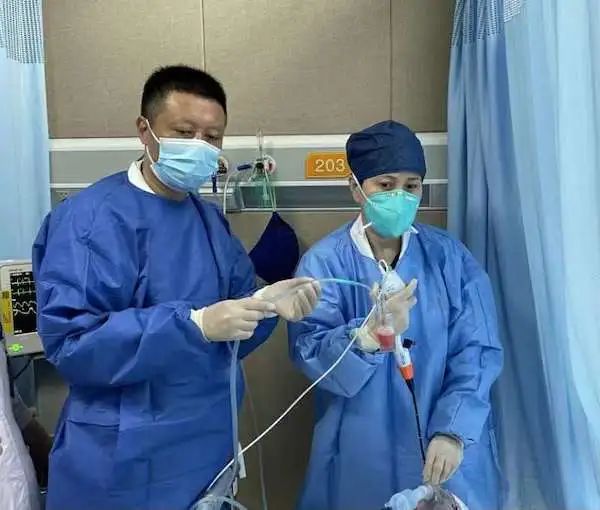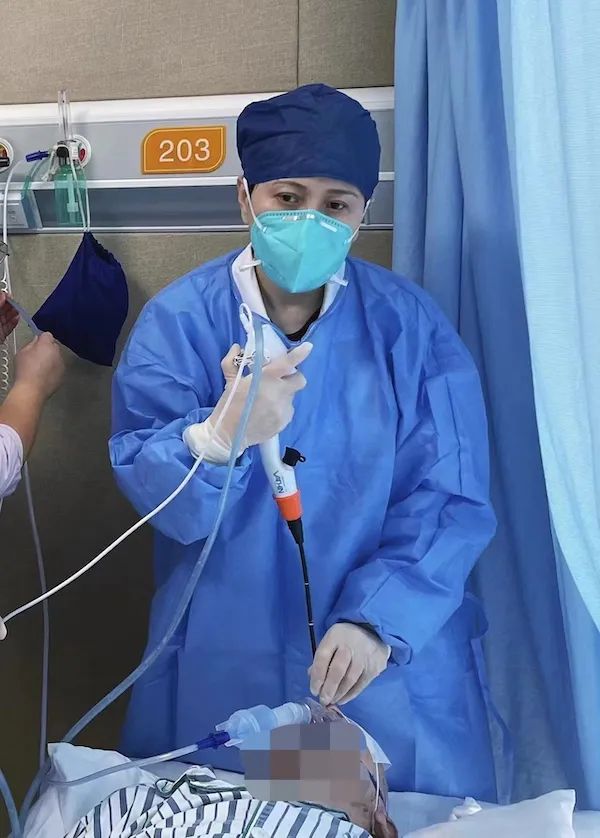 Return list
Return list
The Shibei Hospital successfully rescued an elderly patient using Huaxin Medical's bronchoscope.
“Thanks to the doctor, our family can have a happy Mid-Autumn Festival together again!”
Mr. Xu, a 90 year old man who was once on the brink of death, was discharged today after receiving full treatment and meticulous care from the emergency medical staff of Shibei Hospital in Jing'an District. Mr. Xu's daughter, in her 60s, tightly held the hand of the emergency department director Cao Juan and refused to let go. She gratefully said, "It's really our blessing to meet such a skilled doctor at the hospital at our doorstep!"!”

Picture: Cao Juan is concentrating on performing bedside painless bronchoscopy treatment for patients. Photo by Zhu Rongbin (same below)
病情反复危在旦夕
The emergency department is the busiest place in hospitals, and also one of the departments with the most contact with diseases, the concentration of critically ill patients, and the heaviest rescue tasks. Most patients admitted to the emergency department have acute onset, severe condition, and rapid changes, requiring medical personnel to detect and rescue them as soon as possible, and receive precise treatment. Not long ago, 90 year old Mr. Xu, who lives on Baode Road, experienced continuous fever, coughing, phlegm, and wheezing after experiencing a "two positive" test. On the morning of September 1st, Mr. Xu's symptoms of shortness of breath suddenly worsened, accompanied by fainting. His family immediately called an ambulance to the nearest emergency room of Shibei Hospital. Dr. Xu Guangqing in the emergency department immediately performed corresponding examinations on Mr. Xu, indicating hypoxemia, inflammation of the left lower lobe of the lung, pericardium, and a small amount of pleural effusion on both sides. His condition is very serious. After preliminary examination, Mr. Xu was diagnosed as pneumonia, COVID-19 infection and hypoxemia, coronary atherosclerotic heart disease, atrial fibrillation, lacunar cerebral infarction. Further examination also revealed that the patient had multiple underlying diseases, including severe tricuspid regurgitation, moderate mitral regurgitation, pulmonary hypertension, grade 4 heart failure, and left common carotid artery stenosis with plaque formation. A significant decrease in lymphocyte count suggests extreme immune dysfunction in the elderly, suggesting infection induced bone marrow suppression. After admission to the emergency department, high flow oxygen therapy, standardized antimicrobial therapy, small molecule antiviral drugs, anticoagulation, and related symptomatic supportive treatment will be administered for about 10 days. The patient's body temperature returned to normal and heart failure was effectively controlled, but it was still found that he had hypoxemia, poor sputum production, and no significant improvement in wheezing. Re examination of chest CT shows that pneumonia has progressed compared to before, with increased pleural effusion on both sides.
Dare to take responsibility for saving lives
What should we do? Is it conservative treatment or proactive action? After Cao Juan analyzed the patient's condition, considering that Mr. Xu may be complicated by drug-resistant bacteria and fungal infection after he has COVID-19, if the infection control is not effective, it may lead to the aggravation of Mr. Xu's condition and the emergence of complications, or even death.
In order to save lives and improve the quality of life of patients, Cao Juan suggests that patients undergo bedside painless bronchoscopy examination and treatment to further clarify the pathogen diagnosis, clear sputum in the airway, and guide the next step of treatment.
However, the patient is not only old, but also complicated with coronary heart disease, atrial fibrillation, severe valve regurgitation, pulmonary hypertension, cardiac insufficiency, carotid stenosis, lower limb atherosclerotic plaque formation and other diseases. During bronchoscopy examination and treatment, hypoxemia and strong stimulation may further exacerbate, induce, and exacerbate the risks of heart failure, malignant arrhythmias, thrombus shedding, cerebrovascular accidents, and bleeding. If patients experience restlessness and lack of cooperation during the examination process, it may increase the risk mentioned above.
Cao Juan introduced that precise diagnosis and treatment of pathogens is currently a targeted diagnosis and treatment for difficult and critically infected patients, especially those with difficult diagnosis, unclear bacterial culture, poor treatment effectiveness, and considering some special bacterial infections. It includes diagnosis and treatment measures for body fluids or tissues such as alveolar lavage fluid, blood, cerebrospinal fluid, urine, pus, feces, pleural fluid, and joint fluid, providing good guidance for improving the accuracy and cure rate of patient treatment.
The reason why Cao Juan dares to take responsibility for patients and is willing to take risks is not determined by a sudden impulse or slapping her head, but by adhering to the spirit of science and relying on years of accumulated successful cases and rich experience. Cao Juan is not only proficient in carrying out new technologies such as bronchoscopic lavage, biopsy, precise pathogen diagnosis of blood and puncture fluid, monitoring of drug-resistant bacteria, development and clinical evaluation of rapid diagnosis technology for humoral pathogen infections without culture, but also proficient in interventional treatment of tumors, bronchial stenosis, foreign body removal under bronchoscopy. She is particularly skilled in the diagnosis and treatment of bronchial asthma, small airway inflammation, chronic obstructive pulmonary disease, sleep apnea syndrome, and severe infections.
The patient and their family learned that Cao Juan has been practicing medicine for more than 20 years and has deep expertise in the rescue and treatment of critically ill patients, so they have great trust in Cao Juan.
Accurate diagnosis and treatment to identify the "culprit"
Cao Juan and her team, after careful examination, detailed analysis, and inviting anesthesia and nursing departments to jointly evaluate the relevant risks, developed personalized diagnosis and treatment plans and processes suitable for patients. After fully communicating with the patient and their family and informing them of the risks and pros and cons, Cao Juan's family expressed their agreement to undergo bronchoscopy and subsequent related examinations. When the son of the elderly man abroad learned that the doctors at Shibei Hospital were willing to take risks to examine his elderly father, he greatly admired him.

Picture: Cao Juan is concentrating on performing bedside painless bronchoscopy examination and treatment for the patient
With the assistance of Deputy Director Gao Xinhai and the close cooperation of Nurse Zhang Jinmin's nursing team, Cao Juan remained calm, bold, and meticulous. With her skilled and excellent skills, she successfully performed bronchoscopy on Mr. Xu. During the surgery, it was observed that Mr. Xu's bronchial mucosa at all levels was significantly congested and edematous, with a large amount of yellow purulent phlegm and phlegm clots. He was rinsed with physiological saline and underwent alveolar lavage in both lung lobes. A small amount of alveolar lavage fluid was taken and sent to high-throughput sequencing technology (NGS) for detection. The examination process was smooth, and the patient had no severe coughing or bleeding, with stable vital signs.
The next day, the NGS test results of alveolar lavage fluid returned, indicating that Streptococcus mitis, Acinetobacter baumannii and other multi drug resistant bacteria were infected, and Aspergillus fumigatus was also infected, and 2019 novel coronavirus (B.1.1.529) was detected (the previous antigen test was negative). They immediately adjusted their antimicrobial treatment plan, adding comprehensive treatments such as antifungal drugs and blocking antibodies to regulate immunity.
Through a series of treatments such as high-flow oxygen therapy, immune regulation, and nutritional support, Mr. Xu's condition gradually improved and his condition stabilized, and he was finally discharged from the hospital. He was very happy and gave a thumbs up to the emergency medical staff. The patient's daughter held Cao Juan's hand and sighed, "I never expected that the hospital at our doorstep would have such a good level of medical care!"
In the past month, the Emergency Department of Shibei Hospital has successfully carried out bedside painless bronchoscopy, precise pathogen diagnosis and treatment, and improved the accuracy and cure rate of treatment for 6 difficult, critical, and elderly infected patients, which has been widely recognized by patients.

Illustrated: Close cooperation between medical staff, smooth operation
Who is suitable for this surgery
Director Cao Juan introduced that it is currently the high-incidence season for respiratory diseases. Bronchoscopy, as a commonly used clinical technique, has a wide range of indications and extensive diagnostic value for respiratory diseases.
1、Suspected tracheal, bronchial, or lung tumors or neoplastic lesions.
2、Patients with unexplained hemoptysis lasting for more than one week, especially those over 40 years old, even if no obvious abnormalities are seen on imaging.
3、Patients with undiagnosed, rapidly progressing conditions, poor response to antibiotics, persistent or slowly resolving lesions, clinically diagnosed lower respiratory infections, or those with impaired immune function.
4、New lung lesions after organ or bone marrow transplantation, or suspected graft-versus-host disease or immune rejection of transplanted lungs.
5、Patients with unexplained, progressive, or poorly treated cough, suspected of tracheal or bronchial tumors, foreign bodies, or other lesions.
6、Sudden unexplained wheezing or asthma, especially when snoring or wheezing sounds are heard in a fixed location, requiring exclusion of large airway stenosis or obstruction.
7、Unexplained diffuse parenchymal lung diseases, such as interstitial pneumonia, sarcoidosis, pulmonary alveolar proteinosis, and occupational lung diseases.
8、Suspected patients with airway stenosis。
9、Atelectasis of a unilateral lung, lobe, or segment due to any cause。
10、Suspected airway injury after trauma.
11、Clinical symptoms and imaging manifestations suggesting various tracheal or bronchial fistulas, such as tracheoesophageal fistulas, bronchopleural fistulas, etc.
12、Suspected airway foreign bodies.
13、Unexplained mediastinal lymphadenectasis, mediastinal masses, etc。








 Return list
Return list

